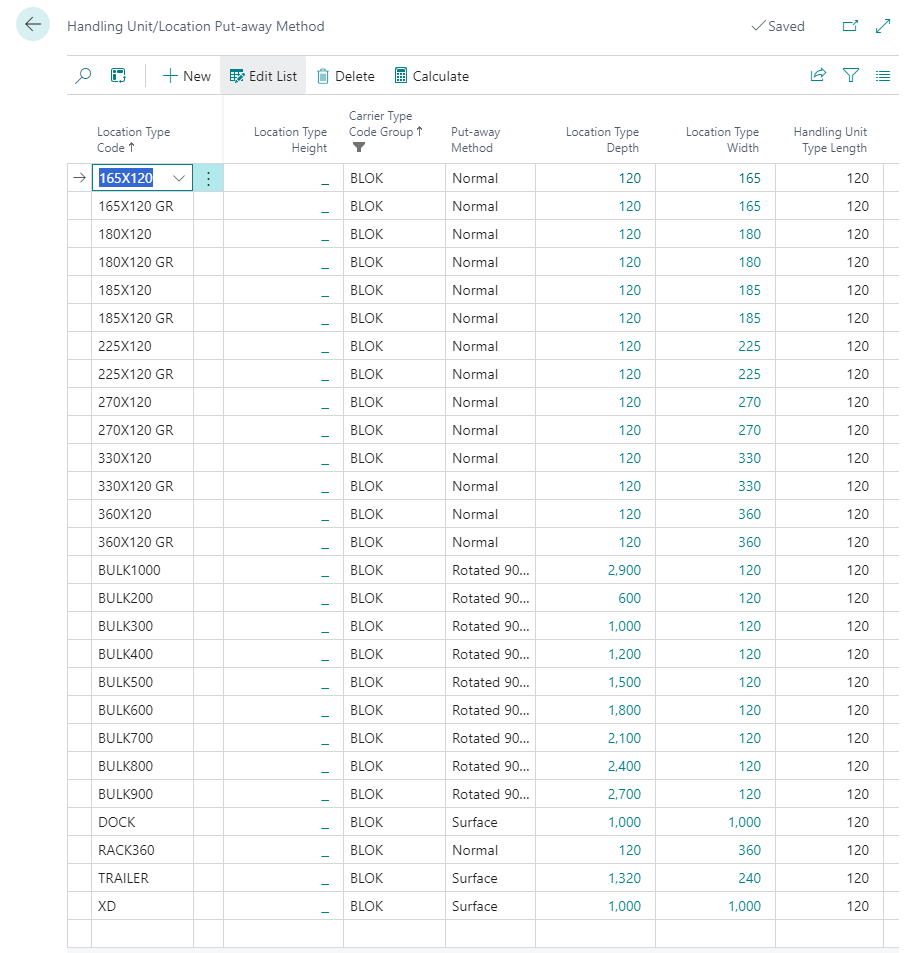Handling Unit Type
A Handling Unit Type is the identifier in 3PL Dynamics to categorize and define different types of handling units. Handling units are physical units in which goods are packed and transported, such as pallets, crates, boxes, or containers. This list typically includes detailed information about each type of handling unit to ensure consistency, efficiency, and accuracy in the handling, storage/location capacity, and transportation of goods

| Field | Description |
|---|---|
| Code | Code of the Handling Unit Type |
| Description | Description of the Handling Unit Type |
| Handling Unit Type Group Code | Group Code, values will be inherited from Handling Unit Type Group Code |
| Length | Length of the Handling Unit Type |
| Width | Widht of the Handling Unit Type |
| Height | Height of the Handling Unit Type |
| Pick Max. Load (Height) | Max Height for the Handling Unit Type, Used with certain transfer strategies |
| Pick Max. Load (Cubage) | Max Cubage for the Handling Unit Type, Used with certain transfer strategies |
| Package No. | Package No. for the Handling Unit Type, used for package calculation in a document. This will create a package document line |
| Tare Weight | Tare Weight of the Handling Unit Type |
| Handling Unit Type Weight | Handling Unit Type Weight |
| Disable Height Calculation | When enabled, the Height will not be recalculated when adjusting the Carrier |
| Capacity Registration | In- or exclude this Handling Unit Type from the location capacity calculation |
| Attribute 01 | Attribute 01, Can be configured in the Attribute Setup |
| Attribute 02 | Attribute 02, Can be configured in the Attribute Setup |
| Attribute 03 | Attribute 03, Can be configured in the Attribute Setup |
| Attribute 04 | Attribute 04, Can be configured in the Attribute Setup |
| Attribute 05 | Attribute 05, Can be configured in the Attribute Setup |
| Attribute 06 | Attribute 06, Can be configured in the Attribute Setup |
| Attribute 07 | Attribute 07, Can be configured in the Attribute Setup |
| Attribute 08 | Attribute 08, Can be configured in the Attribute Setup |
| Attribute 09 | Attribute 09, Can be configured in the Attribute Setup |
| Attribute 10 | Attribute 10, Can be configured in the Attribute Setup |
Handling Unit Type Group
Handling Unit Type will be grouped in Handling Unit Type Groups. This is used to group the Handling Unit Types in a logical way. The Handling Unit Type Group can be used in the setup of the Handling Unit Type to inherit values from the Handling Unit Type Group. And can be used in the setup of the Location to define the capacity of the location, this gives the possibility to define the capacity of the location based on the Handling Unit Type Group, instead of the Handling Unit Type.

Per Package (Package per Handling Unit Type)
Per Handling Unit Type, it is possible to define one or more related Packages. This is used to define the package calculation in a document. When a Handling Unit Type is selected in a document, the related packages will be created as package document lines. Eg. when a Handling Unit Type is a pallet, the related packages can be boxes or crates.

Handling Unit /Location Put-Away Method
Per combination Handling Unit Type / Location is possible to define the Put-Away Method. This is used to define the Put-Away Method for a specific Handling Unit Type in a specific Locationtype. The Put-Away Method can be defined as Normal, Rotated 90 Degrees or Surface.
- Normal: The Handling Unit Type will calculate the remaining capacity based on Length dimension.
- Rotated 90 Degrees: The Handling Unit Type will calculate the remaining capacity based on Width dimension.
- Surface: The Handling Unit Type will calculate the remaining capacity based on the Surface dimension.
The field Max. No. of Handling Units is used to define the maximum number of Handling Units that can be put away in the location. When the maximum number of Handling Units is reached, the location will be full and no more Handling Units can be put away in the location. This field is only in use if you have the Capacity Registration field enabled in the Location Type.
